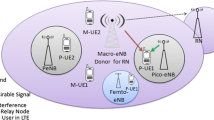Abstract
Long term evolution (LTE) is a recently evolving technology which ensures the reliable delivery of the heterogeneous traffic services with high speed data rate and lower delays through their mobile and other hand held devices. The key feature of LTE is its traffic engineering which is used for effectively managing the network resources for efficient utilization. When LTE expertise has arisen there are some prevailing problems to be taken care of i.e. load balancing and traffic scheduling. Even LTE is the debauched technology, but it is also been anguishing from these problems. In this paper, a load balancing strategy has been espoused that is based on traffic scheduling. Various Traffic scheduling algorithms are designed earlier to assign shared resources among users to optimize the performance of LTE systems in an efficient manner. The performance of three types of scheduling algorithms is compared in this paper namely first come first serve (FCFS), round robin (RR) and hybrid algorithm which is the combination of FCFS and RR in extremes conditions. The discussed scheduling algorithms performance is measured in terms of symbol error rate and signal to noise ratio.





Similar content being viewed by others
References
3GPP. Technical specification group radio access network—physical channel and modulation (Release 8), 3GPP TS 36.211.
Parkvall, S., Dahlman, E., & Furuskar, A. (2008). LTE advanced–evolving LTE towards IMT-advanced. In Proceedings of IEEE vehicular technology conference (pp. 1–5), Singapore: VTC-Spring.
Sesia, S., Toufik, I., & Baker, M. (2009). LTE–The UMTS long term evolution- from theory to practice. New York: Wiley.
Furht, B., & Ahson, S. A. (2009). Long term evolution: 3GPP LTE radio and cellular technology. Boca Raton: CRC Press.
Divya, R., & Huseyin, A. (2009). 3GPP—long term evolution—a technical study. Berlin: Spring.
A Technical White Paper. Long term evolution (LTE): A technical overview. Motorola.
Astely, D., Dahlman, E., Furuskar, A., Jading, Y., Lindstrom, M., & Parkvall, S. LTE: The evolution of mobile broadband. LTE PART11: 3GPP Release, Ericsson Research.
Meyer, M. (2006). ARQ concept for the UMTS long-term evolution. Montreal: VTC Fall.
Bu, T., Li, L., & Ramjee, R. (2006). Generalized proportional fair scheduling in third generation wireless data networks. In IEEE Proc. INFOCOM.
Wang, H., Ding, L., Wu, P., Pan, Z., Liu, N., & You, X. (2010). Dynamic load balancing and throughput optimization in 3GPP LTE networks. Caen: IWCMC.
Son, K., Chong, S., & Veciana, G. (2009). Dynamic association for load balancing and interference avoidance in multi-cell networks. IEEE Transactions on Wireless Communications, 8(7), 3566–3576.
Tonguz, O. K., & Yanmaz, E. (2008). The mathematical theory of dynamic load balancing in cellular networks. IEEE Transactions on Mobile Computing, 7(12), 1504–1518.
Eklundh, B. (1986). Channel utilization and blocking probability in a cellular mobile telephone system with directed retry. IEEE Transactions in Comm., 34(3), 329–337.
Jiang, H., & Rappaport, S. S. (1994). CBWL: A new channel assignment and sharing method for cellular communication systems. IEEE Transactions Vehicular Technology, 43(4), 313–322.
Das, S., Viswanathan, H., & Rittenhouse, G. (2003). Dynamic load balancing through coordinated scheduling in packet data systems. In IEEE Proc. INFOCOM.
Son, K., Chong, S., & Veciana, G. (2009). Dynamic association for load balancing and interference avoidance in multi-cell networks. IEEE Transactions on Wireless Communications, 8(7), 3566–3576.
Gidlund, M., Laneri, J. C. Scheduling algorithms for 3GPP long-term evolution systems: From a quality of service perspective. In 10th IEEE international symposium on spread spectrum techniques and applications (ISSSTA) (pp. 114–117).
Basukala, R., Ramli, H. M., & Sandrasegaran, K. (2009). Performance analysis of EXP/PF and M-LWDF in downlink 3GPP LTE system. In First asian himalayas international conference on internet (pp 1–5).
Wang, Y., Li, G., Wu, T., & Gong, F. (2010). Adaptive proportional fair scheduling in multihop OFDMA systems. In IEEE 71st vehicular technology conference (pp. 1–5).
Yang, C., Wang, W., Qian, Y., & Zhang, X. (2008). A weighted proportional fair scheduling to maximize best-effort service utility in multicell network. In IEEE 19th international symposium on indoor and mobile radio communications (pp. 1–5).
Choi, J. G., & Bahk, S. (2007). Cell-throughput analysis of the proportional fair scheduler in the single-cell environment. IEEE Transactions on Vehicular Technology, 56, 766–778.
Author information
Authors and Affiliations
Corresponding author
Rights and permissions
About this article
Cite this article
Sonia, Khanna, R. & Kumar, N. Load Balancing Efficiency Improvement Using Hybrid Scheduling Algorithm in LTE Systems. Wireless Pers Commun 96, 4299–4311 (2017). https://doi.org/10.1007/s11277-017-4387-9
Published:
Issue Date:
DOI: https://doi.org/10.1007/s11277-017-4387-9




